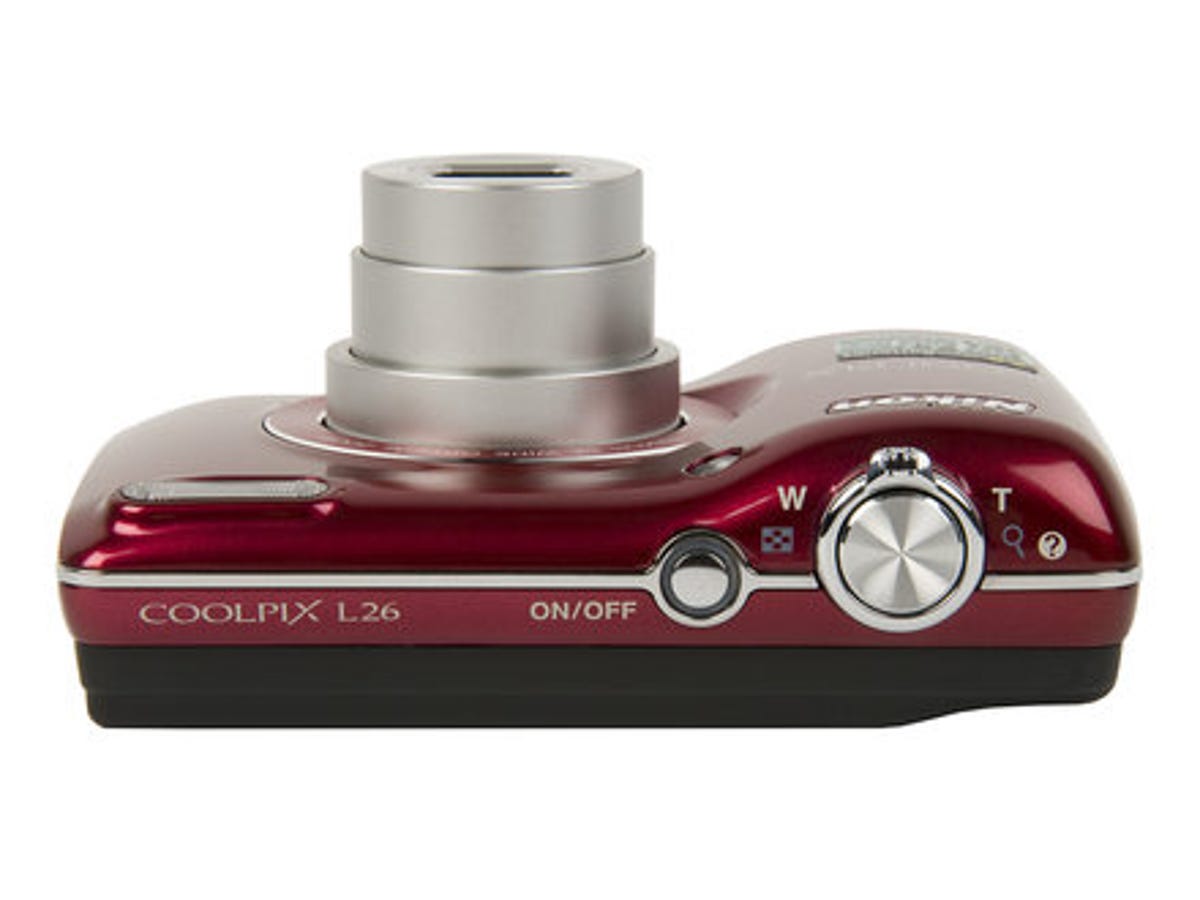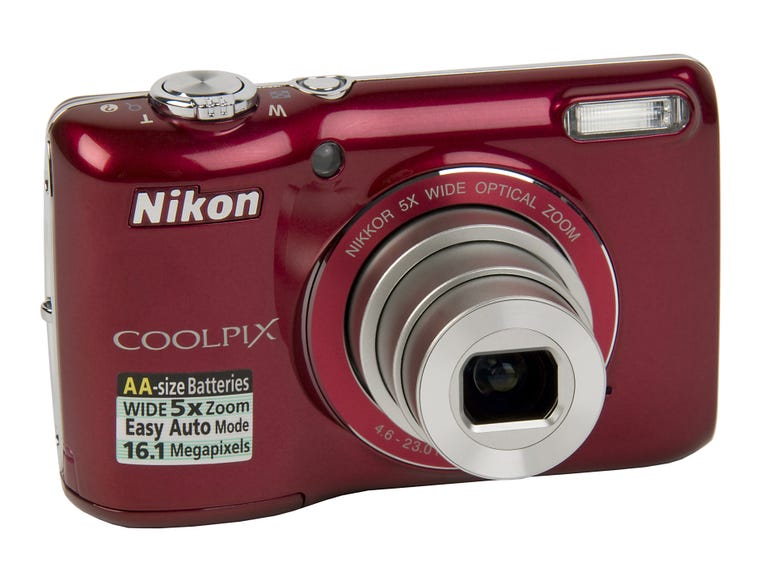 Why You Can Trust CNET
Why You Can Trust CNET Nikon Coolpix L26 review: Nikon Coolpix L26
A compact, no-nonsense camera that's spot-on for kids and less confident photographers.
It might not feel like much when you first get your hands on it, but the Nikon Coolpix L26 is a gem of a camera. With a resolution of 16.1 megapixels and a 5x zoom, it's a great starter kit for less experienced buyers or anyone looking for a first camera.
The Good
The Bad
The Bottom Line
The trouble is, while it may feel like a cheap camera, to qualify on that score it would have to come in at somewhere around the £100 mark. It doesn't, which begs the question, is it worth paying an additional £40 for?
Stills tests
Ignore the unsubtle plastic case, clicky buttons and rear display, which in bright sunlight doesn't do your shots the justice they deserve. They may look slightly washed out in the wild, but downloading them back at base reveals a nice surprise: the L26 actually captures plenty of bold, punchy colours.

The image below is a case in point. All cameras build up an image by detecting varying degrees of red, green and blue illumination -- the three hues that entirely dominate this scene with green grass, blue sky and red brickwork. Each is true to the original, with vibrant green and red and a subtle blue sky that demonstrates a smooth transition between the darker tones at the top of the frame and the lighter blue closer to the horizon.
However, look closer and you'll see flaws. Enlarge the image to 100 per cent and a pink fringe is evident on the tree branches to the extreme left, where the lens has failed to perfectly align each wavelength of incoming light. You can see the same effect on the windows to the left of the church door, and again on the tree-line horizon to the right.
That same fringing is evident in the tips of the yew tree at the extreme left of this image, and again on the trees to the right of the frame.
That suggests it's not an isolated incident, but it certainly wasn't evident in all of my shots, even in broadly similar conditions. In the image below, for example, the branches are cleanly rendered, with well-defined edges on both those near at hand, where they pass over the clapboard shuttering, and in the distance, where they overlay the sky.
In this image of a rusting engine below, the camera produced smooth and unstepped transitions in the level of luminance following the curve of the boiler. There's plenty of detail in the patch of rust underneath the nose of the engine. This was helped in part by the fact that the L26 kept its sensitivity pinned to the very lowest end of the scale, at ISO 80, to reduce the potential for noise in the image.
At closer quarters, it does a great job of capturing a fine level of detail. Although I'd like to see a wider maximum aperture at the shorter end of the zoom, there's still an attractive shallow depth of field, which draws the eye to the focus of your image.
However, when I switched to a more muted situation, where the scene was characterised by less obvious colours, the results lacked a little definition.
In the scene below, of an isolated house in the middle of mud flats, there is very little tonal variation. The sky is white, there's a haze on the horizon, and the mud flats themselves are grey. Even the house is white and grey, which would present any camera with a challenge.
While it has captured the essence of the scene -- particularly when zoomed out or reduced to a size appropriate for web use, enlarging to full size reveals colour interference. Despite keeping the sensitivity low, the L26 has detected a faint range of colours that simply aren't present in this scene in real life. An oily pink and green effect is visible across much of the frame when zoomed to 100 per cent.
It's not uncommon for a camera's weaknesses to be revealed only in zooming the image to 100 per cent, and this is worth bearing in mind when making your choice of camera. Although there are imperfections in the L26's output, both the colour noise and the fringing we saw earlier are only evident on close inspection. If you want to print your shots or use them online, the flaws will likely go unnoticed.
Video test
I was less impressed by the L26's video performance than by its stills. Maximum resolution is a respectable 1,280x720 pixels, which qualifies as HD, but the pictures themselves don't quite match the clarity of a true HD broadcast.
There is no option to suppress wind noise, so if you're shooting in particularly windy conditions, you'll hear this clearly on the soundtrack.
More seriously though, the optical zoom is locked when shooting video, leaving you with only the 4x digital zoom to play with. While your soundtrack isn't spoiled by the noise of the lens motors churning, the result is inferior to that delivered by an optical zoom. For starters, instead of sliding from wide to tight angle, it progresses in a series of small steps. Secondly, the results themselves look slightly scrambled as they're simply an enlarged portion from the centre of the frame.
The movie mode is a nice add-on, but it's not a reason to buy the L26.
Specs
So what's going on under the hood to deliver these results? The 5x optical zoom is equivalent to 26-130mm in a conventional 35mm camera, with an aperture range of f/3.2 to f/6.5. The shortest focusing distance at wide-angle is a fairly long 50cm. It's 80cm at full-telephoto and a rather pedestrian 10cm in macro mode. But get this right and the macro results are sharp, with crisp edges and a smooth fall-off in the level of focus outside of the sweet spot.
The 16.1-megapixel sensor delivers 4,608x3,456-pixel images. Here, sensitivity runs from ISO 80 to ISO 1,600, with compensation of -/+2.0EV in 1/3EV steps.
The rear LCD screen covers 3 inches, while the small bulge that forms the hand grip is home to two AA batteries. On the one hand, this is a blessing as it means you can replace them on pretty much any high street worldwide, so you needn't pack spares before heading to the airport. But if you have one eye on the environment and would rather use rechargeables, you'll have to buy your own, plus a charger.
Conclusion
The L26 is easy to get to grips with. On the whole, the pictures it produces are very good. Colours are bright, detail is sharp in most instances, and only in a few areas did I notice any evidence of chromatic aberration, where fine details were fringed by colours that aren't visible in real life.
Counting against it is its £140 price tag. The L26 feels a little expensive when you can now pick up the Coolpix S6200, which I reviewed back in September, for £110. That has a 16-megapixel sensor, like the L26, but doubles the zoom to 10x. If you prefer something more up to date, then see if you can stretch the budget by £30 and take a look at the Olympus SH-21, which again delivers a 16-megapixel sensor, this time behind a 12.5x zoom.
Despite my pricing concerns, I stand by what I said at the outset -- the L26 is an unpretentious gem for anyone who wants a simple point-and-shoot.


